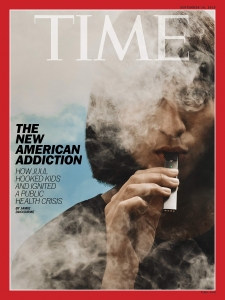Digital media have substantially replaced print media.21 Digital marketing involves new media such as social networking sites and brand websites. Marketing on digital media now far surpasses traditional marketing, especially for adolescents who have on-demand access to content and are active consumers of digital media.22 They are highly susceptible to media influence and are more likely to identify with and to model what they view, and e-cigarette companies are taking advantage of this.22 Since its inception, JUUL Labs, Inc. has heavily utilized social media, spending nearly half of its advertising expenditure on online marketing with a focus on Instagram advertisements.2 JUUL’s first advertising campaign was “Vaporized”, featuring young models and bright colors.3 JUUL also extensively promoted its variety of flavors such as mango and crème brulee, but in 2019 halted sales of pods with flavors other than tobacco and menthol due to public criticism. JUUL also ended its youth-oriented advertisements on social media. JUUL’s official Instagram page @juulvapor discontinued use on November 13, 2018. In 2017, almost half of social media users in 6th, 8th, and 10th grades recalled viewing an e-cigarette advertisement in the previous 6 months. Of these, 40% viewed advertisements on Facebook, 13% on Twitter, and 13% on Instagram.18 23 Exposure to e-cigarette advertising increases the likelihood of future initiation of e-cigarette use.24













